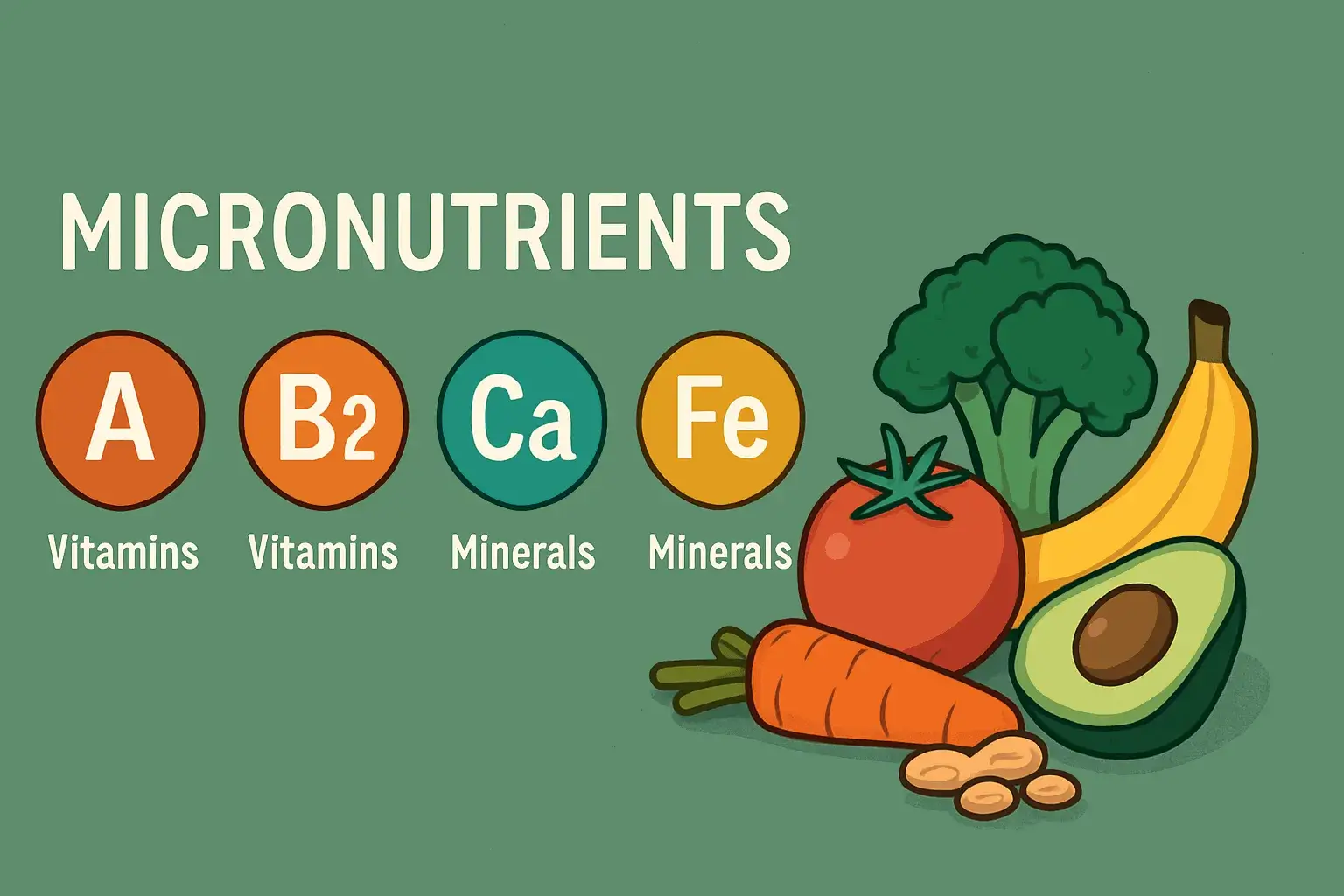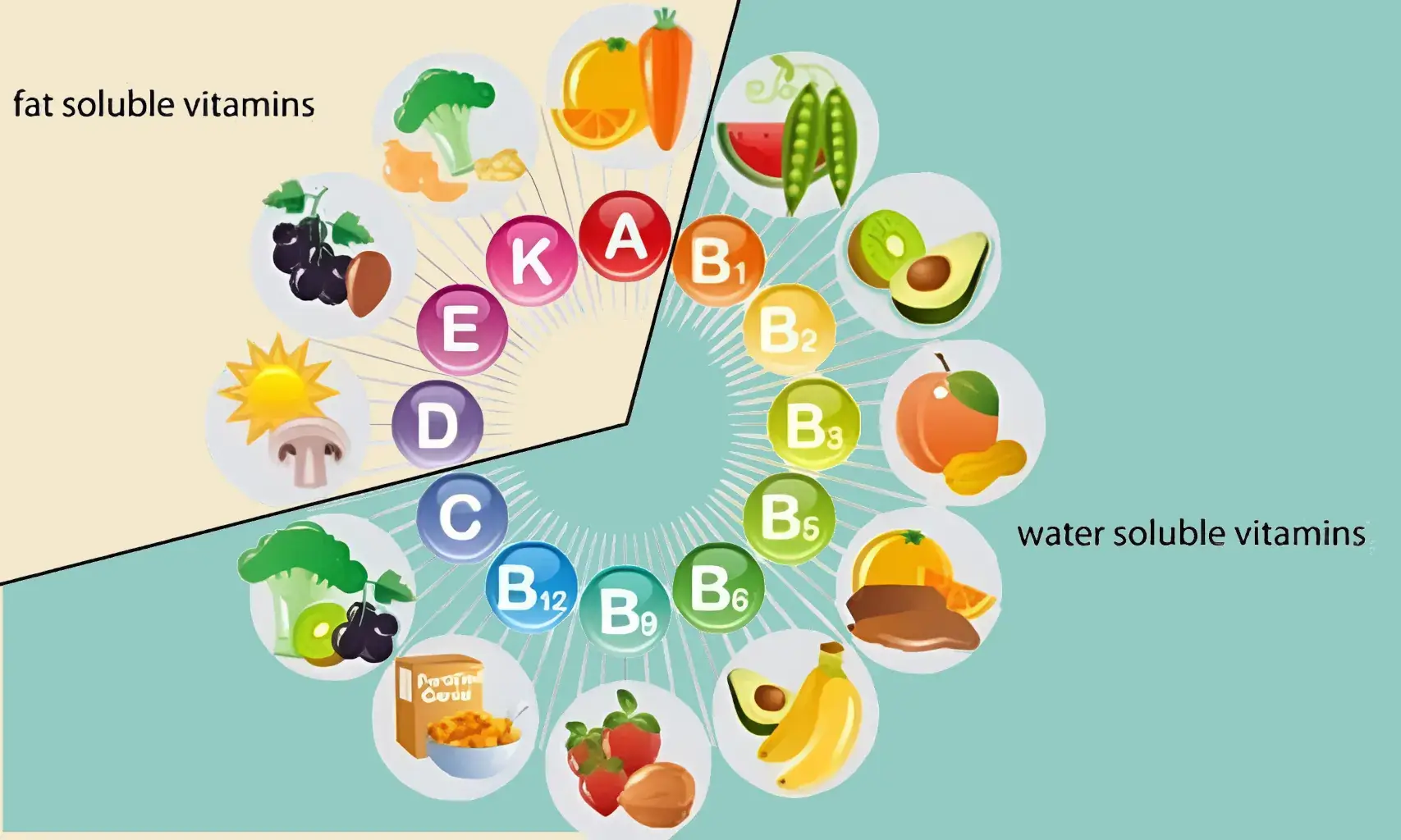
Micronutrients and Micronutrition: A Comprehensive Guide to Types, Benefits, Sources, Deficiencies, and Practical Application
- Marcus Reed
- Nutrition , Wellness
- May 16, 2025
Table of Contents
Fast Facts: Micronutrients & Micronutrition Essentials (TL;DR)
- Vital for Health: Micronutrients (vitamins and minerals) are crucial for countless bodily functions, despite being needed in small amounts.
- Two Main Types: Vitamins (fat-soluble like A, D, E, K; water-soluble like B-complex, C) and Minerals (macrominerals like calcium, magnesium; trace minerals like iron, zinc).
- Diet is Key: Most micronutrients must come from a varied diet rich in fruits, vegetables, whole grains, proteins, and healthy fats.
- Micronutrition Focus: A science-backed dietary approach prioritizing nutrient quality over calorie quantity for optimal metabolism and overall health.
- Deficiency Risks: Inadequate intake can lead to various health issues, emphasizing the need for a balanced diet or targeted supplementation under guidance.
- Personalized Approach: Micronutrition can be tailored to individual needs based on lifestyle, age, health status, and goals.
What Are Micronutrients? An Essential Overview
Micronutrients are vital chemical elements or substances required in trace amounts for the normal growth, development, and metabolic functioning of the human body. This group primarily includes vitamins (such as Vitamin A, C, D, E, K, and the B-complex vitamins) and minerals (including macrominerals like calcium and magnesium, and trace minerals like iron, zinc, and iodine). They are “essential” because the body generally cannot synthesize them at all, or not in sufficient quantities, to meet physiological needs. Therefore, they must be obtained primarily through a diverse and balanced diet, or in some cases, supplementation. [1] [2]
These powerhouse compounds are involved in nearly every bodily process. They act as cofactors for enzymes, contribute to hormone production, support the immune system, enable energy production, maintain bone health, facilitate nerve transmission, ensure proper fluid balance, and protect cells from damage. Understanding the importance of micronutrients is the first step towards optimizing your health through nutrition.
Decoding the Types of Micronutrients
Micronutrients are broadly classified into vitamins and minerals, each with distinct roles and characteristics.
Vitamins: Organic Catalysts for Health
Vitamins are organic compounds that are crucial for various metabolic processes. They are categorized based on their solubility: fat-soluble or water-soluble.

Fat-Soluble Vitamins
These vitamins (A, D, E, and K) dissolve in fat and can be stored in the body’s liver and adipose (fatty) tissues for longer periods. This storage capacity means that excessive intake can potentially lead to toxicity, so it’s important to adhere to recommended dietary allowances (RDAs).
| Vitamin | Key Food Sources | Primary Functions in the Body | Adult RDA (General) [1] [3] |
|---|---|---|---|
| A | Beef liver, eggs, carrots, sweet potatoes, spinach, fish | Essential for vision, immune function, cell growth, bone health | 700–900 mcg RAE* |
| D | Fatty fish (salmon, tuna), fortified milk & cereals, mushrooms, sunlight exposure | Promotes calcium absorption, crucial for bone health, immune function | 15–20 mcg (600-800 IU) |
| E | Nuts (almonds), seeds (sunflower), spinach, broccoli, vegetable oils | Powerful antioxidant, protects cells from damage, supports immune function | 15 mg (alpha-tocopherol) |
| K | Leafy green vegetables (kale, spinach), vegetable oils, blueberries, natto | Vital for blood clotting, bone metabolism | 90–120 mcg |
*RAE: Retinol Activity Equivalents. RDAs can vary based on age, sex, and life stage (e.g., pregnancy).
Water-Soluble Vitamins
These vitamins, which include Vitamin C and the B-complex vitamins, dissolve in water. They are not stored in the body to any significant extent; any excess is typically excreted through urine. This means they need to be consumed more regularly.
| Vitamin | Key Food Sources | Primary Functions in the Body | Adult RDA (General) [1] [3] |
|---|---|---|---|
| C (Ascorbic Acid) | Citrus fruits (oranges, lemons), bell peppers, broccoli, strawberries, kiwi | Antioxidant, collagen synthesis, wound healing, iron absorption, immune support | 75–90 mg |
| B1 (Thiamin) | Whole grains, pork, beef, black beans, nuts | Energy metabolism, nerve function | 1.1–1.2 mg |
| B2 (Riboflavin) | Dairy products, eggs, lean meats, fortified cereals, green leafy vegetables | Energy production, cell function, growth, and development | 1.1–1.3 mg |
| B3 (Niacin) | Poultry, beef, fish, pork, peanuts, fortified breads | Energy metabolism, DNA repair, antioxidant functions, cholesterol balance | 14–16 mg NE** |
| B5 (Pantothenic Acid) | Beef, chicken, avocado, whole grains, mushrooms, nuts | Synthesis of coenzyme A, energy metabolism, hormone production | 5 mg |
| B6 (Pyridoxine) | Chickpeas, poultry (turkey), fish (tuna), potatoes, banana | Amino acid metabolism, neurotransmitter synthesis, immune function, red blood cell formation | 1.3–1.7 mg |
| B7 (Biotin) | Eggs (cooked yolk), beef liver, almonds, salmon, avocado | Carbohydrate, fat, and protein metabolism, enzyme production, hair/skin/nail health | 30 mcg |
| B9 (Folate/Folic Acid) | Leafy green vegetables (spinach), asparagus, beans, lentils, fortified grains | DNA synthesis and repair, cell division, red blood cell formation, crucial for fetal development | 400 mcg DFE*** |
| B12 (Cobalamin) | Animal products (clams, fish, meat, poultry, dairy, eggs), fortified nutritional yeast | Nerve function, DNA synthesis, red blood cell formation | 2.4 mcg |
**NE: Niacin Equivalents. ***DFE: Dietary Folate Equivalents. RDAs are general guidelines.
Minerals: Inorganic Building Blocks and Regulators
Minerals are inorganic elements that originate from the earth and cannot be made by living organisms. Plants obtain them from the soil, and animals (including humans) obtain them by eating plants or other animals. They are categorized into macrominerals and trace minerals based on the amounts needed by the body. [4]
Macrominerals
These are required in relatively larger amounts (typically hundreds of milligrams or more per day).
| Mineral | Key Food Sources | Primary Functions in the Body | Adult RDA (General) [4] [5] |
|---|---|---|---|
| Calcium | Dairy products (milk, cheese, yogurt), tofu, spinach, fortified plant milks, canned fish with bones | Bone and tooth formation/health, muscle contraction, nerve transmission, blood clotting, blood pressure regulation | 1,000–1,300 mg |
| Magnesium | Nuts (almonds, cashews), seeds (pumpkin), spinach, potatoes, brown rice, legumes | Enzyme function, energy production, muscle and nerve function, blood sugar control, blood pressure regulation | 310–420 mg |
| Phosphorus | Dairy products, beef, chicken, fish, lentils, nuts, whole grains | Bone and tooth health, energy metabolism, cell membrane structure, kidney function | 700 mg |
| Potassium | Bananas, potatoes, sweet potatoes, dried fruits (apricots), beans, lentils, spinach | Fluid balance, nerve signals, muscle contractions, heart health, blood pressure regulation | 2,600–3,400 mg (AI****) |
| Sodium | Table salt, processed foods, cured meats, cheese | Fluid balance, nerve transmission, muscle contraction | 1,500 mg (AI, with an upper limit of 2,300 mg) [6] |
| Sulfur | Found in protein-rich foods (eggs, meat, fish, poultry), broccoli, onions, garlic | Component of amino acids (methionine, cysteine), protein synthesis, detoxification | None established (obtained via protein intake) |
****AI: Adequate Intake.
Trace Minerals
These are needed in much smaller amounts (typically micrograms or a few milligrams per day) but are equally vital for health.
| Mineral | Key Food Sources | Primary Functions in the Body | Adult RDA (General) [4] [5] |
|---|---|---|---|
| Copper | Shellfish (oysters), nuts (cashews), seeds, whole grains, mushrooms, liver | Iron metabolism, connective tissue formation, energy production, nervous system health, immune support | 900 mcg |
| Chromium | Broccoli, pork, Brewer’s yeast, grape juice, orange juice, whole grains | Enhances insulin action, carbohydrate and lipid metabolism | 20–35 mcg (AI) |
| Fluoride | Fluoridated water, tea, coffee, shrimp | Dental health (strengthens tooth enamel, prevents cavities) | 3–4 mg (AI) |
| Iodine | Iodized salt, seafood (seaweed, cod), dairy products, eggs | Thyroid hormone synthesis (regulates metabolism, growth, development) | 150 mcg |
| Iron | Red meat (beef), poultry, fish, lentils, beans, spinach, fortified grains | Oxygen transport (component of hemoglobin), energy production, immune function, anemia prevention | 8–18 mg (varies significantly by age/sex) |
| Manganese | Clams, nuts (pecans), seeds, whole grains, tea, coffee, leafy vegetables | Bone formation, enzyme activation, metabolism of carbohydrates, amino acids, and cholesterol | 1.8–2.3 mg (AI) |
| Molybdenum | Legumes (beans, lentils, peas), nuts, grains, milk | Enzyme cofactor for metabolism of sulfur-containing amino acids and certain toxins | 45 mcg |
| Selenium | Brazil nuts, seafood (tuna, sardines), beef, poultry, dairy, whole grains | Antioxidant (component of glutathione peroxidase), thyroid hormone metabolism, immune function, reproductive health | 55 mcg |
| Zinc | Oysters, red meat, poultry, pumpkin seeds, chickpeas, cheese, fortified cereals | Immune function, wound healing, cell division, DNA synthesis, protein synthesis, sense of taste and smell | 8–11 mg |
A varied diet is paramount to ensure an adequate intake of this wide array of essential micronutrients.
What Is Micronutrition? A Personalized Path to Wellness
Micronutrition is an evidence-based dietary and therapeutic approach that emphasizes the optimal intake and balance of essential micronutrients—vitamins, minerals, trace elements, antioxidants, and essential fatty acids. Its primary goal is to enhance metabolic efficiency, support cellular functions, prevent nutrient deficiencies, and thereby improve overall health and well-being. [11]
Unlike approaches that focus solely on calorie counting or macronutrient ratios, micronutrition prioritizes the quality and density of nutrients within the foods consumed. It recognizes that even with adequate caloric intake, deficiencies or imbalances in micronutrients can impair physiological processes and contribute to both acute symptoms and chronic health conditions. This personalized strategy aims to move beyond simply meeting minimum requirements, striving instead for optimal nutrient levels tailored to an individual’s unique biochemical needs.
Key Benefits of Optimizing Micronutrient Intake
A well-managed micronutrient status, often guided by the principles of micronutrition, underpins numerous aspects of health and offers significant benefits:
- Improved Energy Levels and Reduced Fatigue: Many B-vitamins, iron, and magnesium are crucial for energy production pathways.
- Enhanced Cognitive Function: Nutrients like B-vitamins, omega-3 fatty acids (often considered in micronutrition strategies), iron, zinc, and antioxidants support brain health, focus, and mood stability.
- Stronger Immune System: Vitamins A, C, D, E, B6, B12, folate, zinc, iron, copper, and selenium are vital for a robust immune response. [10]
- Reduced Risk of Chronic Diseases: Adequate micronutrient intake is associated with a lower risk of conditions like cardiovascular disease (e.g., through folate, B6, B12, magnesium, potassium), certain cancers (e.g., antioxidants), type 2 diabetes, and osteoporosis (e.g., calcium, vitamin D, vitamin K).
- Better Digestive Health: Certain micronutrients support gut integrity and the microbiome.
- Improved Sleep Quality: Magnesium and certain B vitamins can play a role in regulating sleep.
- Support for Physical and Emotional Wellness: Overall nutrient sufficiency contributes to better stress resilience and mood.
Micronutrition principles are particularly beneficial during specific life stages or for individuals with particular needs:
- Children & Teenagers: Supports optimal growth, cognitive development, and immune maturation.
- Students: Enhances concentration, memory, and mood regulation during demanding study periods.
- Athletes: Optimizes energy production, reduces exercise-induced fatigue and cramps, supports muscle repair, and minimizes injury risk.
- Pregnant Women: Essential for maternal health and proper fetal development, significantly reducing risks of birth defects (e.g., folate). [12]
- Menopausal Women: Helps manage symptoms like hot flashes, mood changes, weight gain, and supports bone health to prevent osteoporosis.
- Overweight or Obese Individuals: Can help address underlying nutrient deficiencies that may contribute to appetite dysregulation, inflammation, and metabolic imbalances.
Micronutrients vs. Macronutrients: Understanding the Difference
It’s crucial to distinguish between micronutrients and macronutrients, as both are essential but play different roles:
| Feature | Macronutrients | Micronutrients |
|---|---|---|
| Quantity Needed | Larger amounts (grams) | Smaller amounts (milligrams or micrograms) |
| Primary Role | Provide energy (calories), building blocks for tissues | Regulate metabolic processes, support enzyme function, hormone production, cellular health |
| Examples | Carbohydrates, Proteins, Fats | Vitamins (A, C, B-complex, etc.), Minerals (Iron, Calcium, Zinc, etc.) |
While macronutrients are the fuel and building materials for the body, micronutrients are the “spark plugs” and “lubricants”—they enable the countless chemical reactions necessary for life. [7] They work synergistically; for example, B-vitamins are essential for metabolizing carbohydrates, fats, and proteins into usable energy.
How Does Micronutrition Work in Practice?
Micronutrition involves a tailored and often investigative approach to dietary planning. Practitioners typically:
Conduct a Comprehensive Assessment: This includes:
- Detailed discussion of health goals, lifestyle factors (work, stress levels, sleep patterns, physical activity).
- Thorough review of dietary habits, food preferences, and relationship with food.
- Analysis of medical history, current health conditions, and any medications or supplements being taken.
- Functional testing, which may include blood tests to assess levels of specific vitamins, minerals, antioxidants, and fatty acids, or tests for markers of inflammation or metabolic dysfunction.
Identify Deficiencies and Imbalances: Based on the assessment, specific nutrient deficiencies, excesses, or imbalances are identified.
Develop a Personalized Plan: A customized dietary strategy is created. This plan emphasizes:
- Whole foods rich in the identified necessary vitamins (e.g., A, B-complex, C, D, E, K) and minerals (e.g., iron, magnesium, calcium, zinc, selenium).
- Specific food recommendations and meal planning guidance.
- Potentially, targeted, high-quality supplementation if deficiencies are significant or dietary intake is insufficient to meet needs (e.g., vitamin D in winter, iron for anemia).
- Lifestyle recommendations that support nutrient absorption and overall health (e.g., stress management, sleep hygiene).
This personalized strategy ensures that individuals receive an optimal intake of micronutrients tailored to their specific needs, supporting both immediate well-being and long-term health.
Who Practices Micronutrition?
Micronutrition is often practiced by healthcare professionals with specialized training in nutrition, functional medicine, or integrative health. This can include:
- Registered Dietitians (RDs) or Registered Dietitian Nutritionists (RDNs) with advanced training in micronutrient therapy.
- Certified Nutrition Specialists (CNSs).
- Medical Doctors (MDs) or Doctors of Osteopathic Medicine (DOs) specializing in functional, integrative, or nutritional medicine.
- Naturopathic Doctors (NDs).
These practitioners use evidence-based approaches, often incorporating biological assessments (like blood tests) to identify specific nutrient deficiencies or imbalances and then create targeted dietary and lifestyle interventions. It is crucial to seek guidance from a qualified and credentialed professional to ensure safe and effective micronutrient strategies.
Building a Micronutrition-Focused Diet: Core Principles
While personalized plans are key in micronutrition, some general principles guide the construction of a micronutrient-rich diet. Referencing broad dietary guidelines, such as those provided by ANSES (French Agency for Food, Environmental and Occupational Health & Safety) or the Dietary Guidelines for Americans [5], can offer a foundational structure. A balanced meal composition is generally encouraged:
- Approximately 40–55% Carbohydrates: Prioritize complex carbohydrates from whole grains (oats, quinoa, brown rice), starchy vegetables (sweet potatoes, squash), fruits, and legumes, which are also rich in fiber and micronutrients.
- Approximately 20–35% Lipids (Fats): Focus on healthy fats from sources like fatty fish (salmon, mackerel - rich in omega-3s), nuts, seeds (flax, chia), avocados, and unrefined oils (olive, avocado oil).
- Approximately 10–35% Protein: Include lean meats, poultry, fish, eggs, dairy products (yogurt, cheese), and plant-based proteins like legumes, tofu, and tempeh. [9]

Practical Tips for Maximizing Micronutrient Intake Daily
Incorporating micronutrient-rich foods into your daily routine doesn’t have to be complicated. Here are some actionable tips:
- Eat the Rainbow: Consume a wide variety of colorful fruits and vegetables daily. Different colors often signify different phytonutrients and vitamins.
- Prioritize Whole Foods: Choose whole, unprocessed foods over refined and packaged items, which often have nutrients stripped away and may contain added sugars, unhealthy fats, and sodium.
- Gentle Cooking Methods: Preserve heat-sensitive nutrients like Vitamin C and some B-vitamins by using gentle cooking methods such as steaming, stir-frying, or microwaving. Raw consumption of certain fruits and vegetables is also beneficial.
- Don’t Discard Nutrient-Rich Parts: Skins of potatoes and apples, or the cooking water from vegetables (if not overcooked), can retain nutrients. Consider using vegetable cooking water in soups or sauces.
- Choose Diverse Healthy Fats: Incorporate a variety of fats, including sources of omega-3 (flaxseed oil, walnuts, fatty fish) and omega-6 (sunflower seeds, walnuts) in balance.
- Embrace Whole Grains and Legumes: These are excellent sources of B-vitamins, minerals like iron and magnesium, and fiber.
- Cook Meals From Scratch: This gives you full control over ingredients and preparation methods, maximizing nutrient retention.
- Strategic Food Pairing: Some nutrients enhance the absorption of others. For example, Vitamin C aids iron absorption (e.g., bell peppers with beans).
Example: The Humble Apple – Raw vs. Processed
Consider an apple to understand nutrient differences based on preparation:
- Eaten Raw (with skin): Provides maximum Vitamin C, dietary fiber (especially pectin in and under the skin), and various antioxidants like quercetin. Supports digestion, promotes satiety, and helps regulate blood sugar.
- Processed into Clear Apple Juice: Much of the dietary fiber is lost. Heat used in pasteurization can reduce levels of heat-sensitive vitamins like Vitamin C. The concentrated sugars without fiber can lead to quicker spikes in blood sugar.
The Powerful Health Benefits of Micronutrients
Micronutrients are indispensable for growth, development, immune function, energy metabolism, and the prevention of diseases. Their benefits are vast and interconnected: [11]
- Growth and Development: Essential from fetal development through adulthood. For example, folate (Vitamin B9) is critical in preventing neural tube defects in newborns and supports DNA synthesis throughout life. Iodine is crucial for thyroid hormone production, which governs brain development and metabolic rate.
- Bone Health: Calcium, Vitamin D, Vitamin K, and phosphorus work synergistically to build and maintain strong bones and teeth, preventing conditions like osteoporosis.
- Immune Defense: A wide range of micronutrients, including Vitamins A, C, D, E, B6, B12, folate, zinc, iron, copper, and selenium, are vital for the development and function of immune cells, protecting the body against infections and diseases. [10]
- Antioxidant Protection: Vitamins A (as carotenoids), C, E, and minerals like selenium and zinc act as powerful antioxidants. They neutralize harmful free radicals, protecting cells from oxidative stress and damage, which is implicated in aging and many chronic diseases.
- Energy Production: B-vitamins (thiamin, riboflavin, niacin, pantothenic acid, B6, biotin, B12) are coenzymes in the metabolic pathways that convert carbohydrates, fats, and proteins from food into usable energy. Iron is essential for oxygen transport, which is also critical for energy production.
Understanding and Preventing Micronutrient Deficiencies
Micronutrient deficiencies occur when the intake or absorption of a vitamin or mineral is too low to meet the body’s needs. These deficiencies can be widespread and lead to a range of serious health problems. Some common global deficiencies include iron, Vitamin A, Vitamin D, iodine, and zinc. [2]
Symptoms can be subtle at first but can become severe if not addressed:
| Deficiency Type | Common Symptoms and Potential Long-Term Consequences |
|---|---|
| Iron | Fatigue, weakness, pale skin, shortness of breath, dizziness, headaches, iron-deficiency anemia. In children, can impair cognitive development. |
| Vitamin A | Night blindness, dry eyes (xerophthalmia), increased susceptibility to infections, skin problems. Severe deficiency can lead to permanent blindness. |
| Vitamin D | Muscle weakness, bone pain, fatigue, increased risk of fractures, rickets in children, osteomalacia/osteoporosis in adults. Linked to immune dysfunction. |
| Zinc | Impaired immune function, hair loss, diarrhea, delayed wound healing, loss of appetite, taste abnormalities, stunted growth in children. |
| Iodine | Goiter (enlarged thyroid gland), hypothyroidism, fatigue, weight gain. In pregnancy, can lead to intellectual disabilities in infants (cretinism). |
| Folate (Vitamin B9) | Fatigue, irritability, megaloblastic anemia. Deficiency during pregnancy significantly increases the risk of neural tube defects in the fetus. |
| Vitamin B12 | Fatigue, weakness, constipation, loss of appetite, weight loss, megaloblastic anemia, neurological changes (numbness and tingling in hands/feet), depression, confusion. |
| Calcium | Muscle cramps, numbness/tingling in fingers, fatigue, poor appetite. Long-term: osteopenia, osteoporosis, increased fracture risk. |
If you suspect a micronutrient deficiency, it’s crucial to consult a healthcare professional for proper diagnosis (often via blood tests) and guidance on appropriate dietary changes or supplementation. Self-diagnosing or over-supplementing can be harmful.
Conclusion: Embracing Micronutrition for Lifelong Vitality

Micronutrients are the unsung heroes of our health, indispensable for nearly every bodily function, from energy production and immune defense to growth and disease prevention. While required in small quantities, their impact is monumental. A diverse, whole-food diet rich in fruits, vegetables, whole grains, lean proteins, and healthy fats is the cornerstone for obtaining these essential vitamins and minerals.
Micronutrition builds upon this foundation by offering a more personalized and targeted approach to optimize nutrient intake based on individual needs, life stages, and health goals. Whether you are a growing child, a busy student, an active athlete, an expectant mother, or an individual navigating the stresses of modern life or managing weight, the principles of micronutrition can provide tailored solutions to enhance both physical and mental well-being.
The ultimate aim is to cultivate a mindful approach to eating—choosing fresh, seasonal, locally sourced, and, where possible, organic foods. Listen to your body, enjoy your meals, and focus on what nourishes you, not just fills you. By making informed and gradual adjustments to your dietary choices, you can harness the power of micronutrients to achieve lasting wellness and vitality.
Frequently Asked Questions (Q&A)
Q1: What are the primary differences between micronutrients and macronutrients?
Q2: How can I ensure I'm getting enough micronutrients daily?
Q3: What are common signs of micronutrient deficiencies?
Q4: Is it better to get micronutrients from food or supplements?
Q5: What is the role of micronutrition in preventing chronic diseases?
Disclaimer
The information provided on BioBrain is intended for educational purposes only and is grounded in science, common sense, and evidence-based medicine. It is not a substitute for professional medical advice, diagnosis, or treatment. Always consult a qualified healthcare provider before making significant changes to your diet, exercise routine, or overall health plan.
References
- National Institutes of Health (NIH) Office of Dietary Supplements (n.d.) "Vitamin and Mineral Supplement Fact Sheets"
- World Health Organization (WHO) (n.d.) "Micronutrients"
- Harvard T.H. Chan School of Public Health (n.d.) "The Nutrition Source: Vitamins"
- Harvard T.H. Chan School of Public Health (n.d.) "The Nutrition Source: Minerals"
- U.S. Department of Agriculture and U.S. Department of Health and Human Services (2020) "Dietary Guidelines for Americans, 2020-2025 (9th ed.)"
- American Heart Association (2021) "How much sodium should I eat per day?"
- National Institute on Aging (NIA) (2022) "Important Nutrients to Know: Proteins, Carbohydrates, and Fats"
- British Nutrition Foundation (n.d.) "Minerals and Trace Elements"
- U.S. Department of Agriculture (n.d.) "MyPlate: Nutrients and health benefits - Protein Foods"
- Maggini, S., Pierre, A., & Calder, P. C. (2018) "Immune Function and Micronutrient Requirements Change over the Life Course"
- Shenkin, A. (2006) "Micronutrients in health and disease"
- Kominiarek, M. A., & Rajan, P. (2016) "Nutrition Recommendations in Pregnancy and Lactation"
Tags :
- Micronutrients
- Vitamins
- Minerals
- Micronutrition
- Dietary reference intakes
- Nutrient deficiencies
- Balanced diet
- Preventive health
- Optimal nutrition